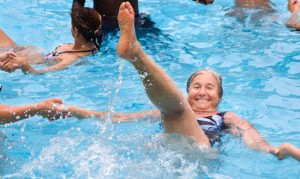 Last week, we discussed the evidence on using exercise to treat depression. This week, there is a new review on the benefits of exercise – this time to treat heart disease.
Last week, we discussed the evidence on using exercise to treat depression. This week, there is a new review on the benefits of exercise – this time to treat heart disease.
The review – written by researchers at Stanford and Harvard universities and published in the British Medical Journal – was the largest of its kind on exercise and heart disease. It combined data from more than 300 studies with nearly 340,000 participants.
Its main conclusions are striking: It found that exercise and drug treatment were statistically equivalent in their effects on heart disease and prediabetes. And exercise was more effective among patients recovering from strokes. Essentially, exercise treatment worked just as well as prescription medicines for treating heart disease, and better than prescription medicines for treating stroke patients.
The review included studies that tested a wide variety of medicines including statins and beta blockers for coronary heart disease; anticoagulants and antiplatelets for stroke; and diuretics and beta blockers for heart failure.
“In cases where drug options provide only modest benefit, patients deserve to understand the relative impact that physical activity might have on their condition,” the authors wrote. “Exercise interventions should therefore be considered as a viable alternative to, or, alongside, drug therapy.”
The authors did note some limitations in their data. The definition of exercise and the frequency, intensity and duration varied across the included trials, which limits the ability to generalize the findings to different forms of physical activity.
That said, the take home message for this topic is clear: Get moving! It’s the best way to protect against and treat cardiovascular disease.



An excellent article. I am currently doing research for an article on exercising after stroke – your post is timely!
A typical directive from physicians and family members after an older adult has had some type of health event is ‘to take it easy’. Generally, people find it is easier to take a pill and take it easy than they do any other action they could take – especially exercise.
I recently watched a webinar with Sir Gray, the Director of the National Knowledge Service and Chief Knowledge Officer to the National Health Service, UK. His current work is focused on demonstrating how the problems of aging can be pushed passed our 70’s and 80’s and well into our 90’s with the right lifestyle choices.
He stressed the older you get, the MORE action you have to take in order to stay healthy. Getting older is NOT the problem – reducing the amount of exercise and activity is the problem. Loss of fitness is the issue.
We have to continue to work at getting the message out about the benefits of exercise. I try to encourage myself by saying there have been changes over the years with important issues such as smoking, recycling, seat belt use… Over time, education leads to increased awareness which leads to a change in attitudes and behaviors.
The fact that “exercise and drug treatment were statistically equivalent in their effects on heart disease and prediabetes…and exercise was more effective among patients recovering from strokes” is groundbreaking news.
We have taken one approach to tackling the problem that many older adults have – they cannot get to the gym. We have created QuickFitnessForZoomers.com – online fitness for boomers and seniors who want to age with ‘zip.’
Professionally designed fitness routines are split into 2 categories: Quick Zoom for mobile active boomers and seniors; and Quick Boom for those who are less mobile and may even use a walker or wheelchair. Quick Boom can be done when a person’s health care aide or a family member visits.
Sadly, people still have to ‘DO IT’ but hopefully we have removed one more barrier. All ages and all fitness levels can exercise anytime, anywhere, 24/7 – all they need is an Internet connection.
Fascinating, Suzanne. Thanks for your comment!